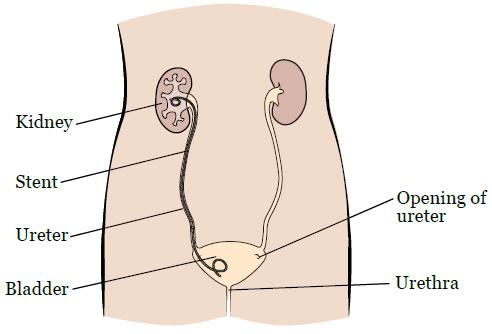(Temporary Tube to Support Urine Flow from Kidney to Bladder)
What Is a Ureteric Stent?
A ureteric stent (also known as a ureteral stent) is a thin, flexible tube inserted into the ureter — the duct that carries urine from the kidney to the bladder. The stent helps to keep the ureter open and ensure proper urine drainage, especially when the ureter is blocked or narrowed due to stones, swelling, surgery, or tumours.
Most ureteric stents are shaped like a double-J (JJ stent), with curls at both ends to prevent movement and maintain position inside the kidney and bladder.

Why Is a Ureteric Stent Used?
Stents may be used to:
-
Relieve a blocked ureter (e.g. due to kidney stones or tumours)
-
Support the ureter after surgery or injury
-
Assist healing after procedures like ureteroscopy or stone removal
-
Prevent or treat infections caused by urine back-up
-
Bypass strictures or scar tissue in the ureter
How Is a Ureteric Stent Inserted?
-
The procedure is typically done under general or spinal anaesthesia.
-
A cystoscope (a thin camera) is inserted through the urethra and bladder.
-
The stent is guided up the ureter into position using x-ray or ultrasound guidance.
-
The procedure takes around 15–30 minutes and is usually performed as a day case or short hospital stay.
In some cases, the stent may be placed during a more complex procedure, such as ureteroscopy or kidney stone surgery.
What Does It Feel Like to Have a Ureteric Stent?
While the stent is in place, some patients experience:
-
Mild discomfort or pressure in the bladder or flank
-
Increased frequency or urgency to urinate
-
Burning sensation during urination
-
Blood in the urine (pink-tinged, usually mild)
-
Discomfort during physical activity
These symptoms are usually temporary and manageable, and vary from person to person.

Stent Removal
Stents are not permanent and are usually removed after a few days to weeks, depending on the reason for placement. Removal methods include:
-
Cystoscopy: Performed in a clinic or hospital under local anaesthetic.
-
Tethered string method: In some cases, a string attached to the stent is left outside the body to allow easy removal without cystoscopy.
It is important to attend your follow-up appointment — leaving a stent in too long can increase the risk of infection, encrustation, or blockage.
